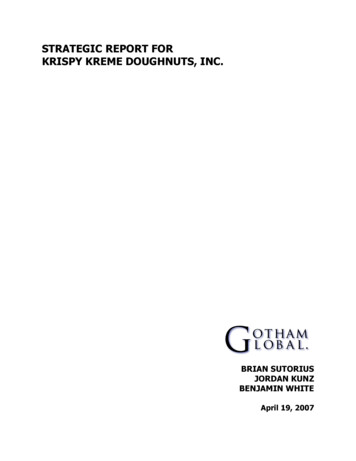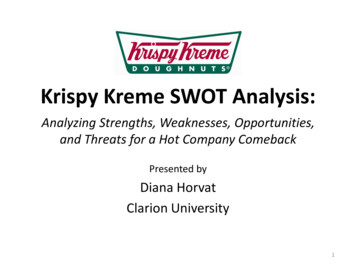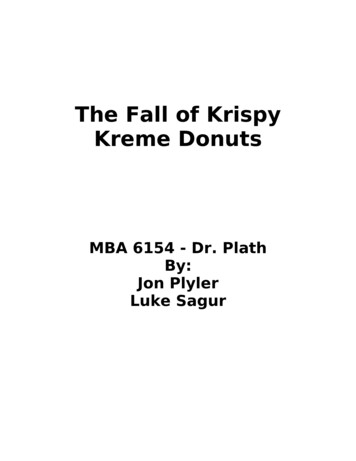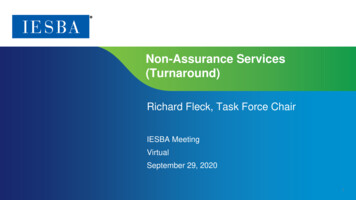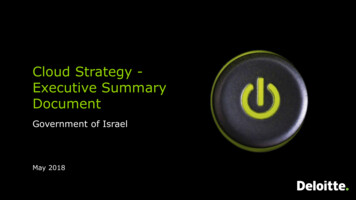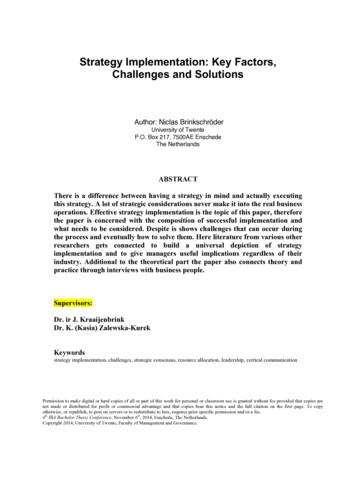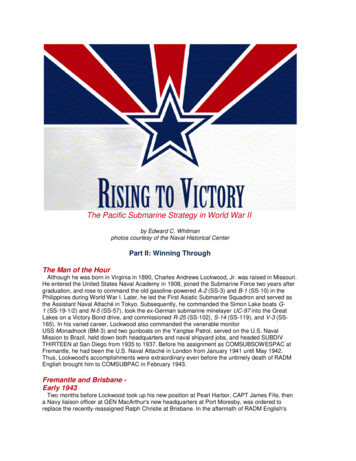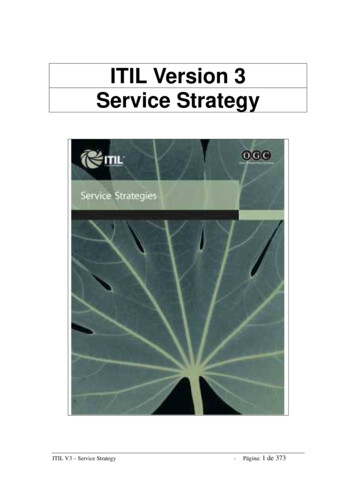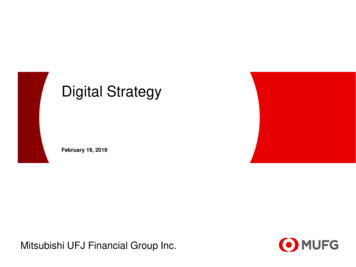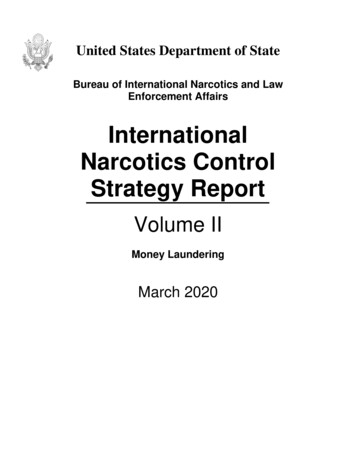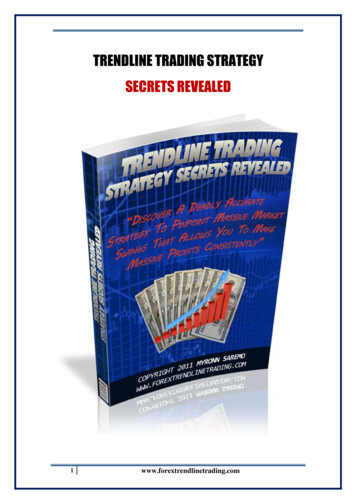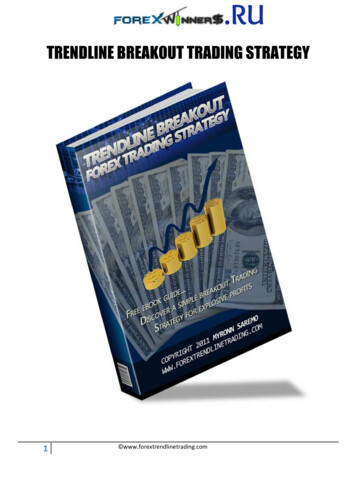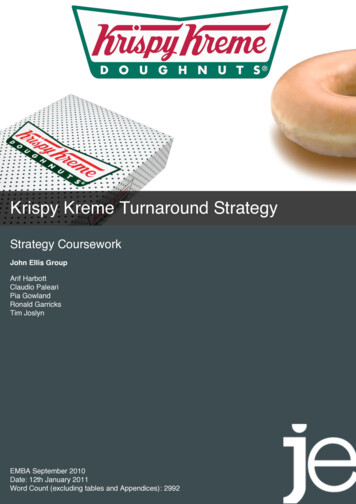
Transcription
Krispy Kreme Turnaround StrategyStrategy CourseworkJohn Ellis GroupArif HarbottClaudio PaleariPia GowlandRonald GarricksTim JoslynEMBA EMBASeptember2010 1 - John Ellis Group v016.pdfSep10 StrategyDate: 12th January 2011Word Count (excluding tables and Appendices): 2992Page 1
Table of Contents1 Introduction . 32 Current strategy . 33 External Analysis . 33.13.23.33.4Industry definition . 3PEST analysis . 3Industry five forces . 4Competition analysis . 64 Analysis of internal environment . 94.14.2Internal value chain . 9Financial analysis . 105 Key themes from analysis. 116 Recommendations . 116.16.26.3Abandon large format stores and sell via third party retailers using mobile kiosks . 12Develop new distribution capabilities . 12Sell direct online targeting businesses . 137 Implementation plan . 14Appendix A – Competition Identification. 15Appendix B – Consumer Research . 18Appendix C – Interviews with Krispy Kreme Staff . 20Appendix D – Internal Analysis . 21Appendix E – Mobile Kiosks . 23Appendix F – Financial Modelling . 24Appendix G – Value Curve Analysis . 25Appendix H – How analysis can be improved . 26Appendix I – Krispy Kreme historical Revenues . 27Bibliography. 28EMBA Sep10 Strategy 1 - John Ellis Group v016.pdfPage 2
1 IntroductionIn 2003 Krispy Kreme was named by Fortune Magazine as ʻAmericaʼs Hottest Brand” andin 2004 they reported net income of 50 million. However over-expansion, an expensivestore network, revelations of falsified financial reports and changing trends in diet havemeant that Krispy Kreme revenues have declined by 50% between 2005 and 20101.The strategic problem considered is to analyse Krispy Kremeʼs current operations andsuggest recommendations for how this may be tailored for the UK market for long-termprofitability given cultural and retail differences.2 Current strategyKrispy Kreme operates 582 stores (including franchised) in 18 countries worldwide. Storesrange from 4,000 to 8,000 square feet and are generally located in freestanding suburbanlocations. They also operate smaller satellite stores, kiosks and sell directly through largeretailers such as Tesco.Krispy Kreme is a vertically integrated business. Starting with their secret recipe, they makefresh doughnut mix each day, which is distributed to all stores. They manufacture their owndoughnut and coffee machinery. Doughnuts are freshly made; they have a simple productline focused on doughnut variations and their own branded coffee (developed from theacquisition of Digital Java in 2001).In the UK Krispy Kreme operates a subsidiary (with a 34% equity interest) with an exclusivedevelopment licence to the franchise in the UK.3 External Analysis3.1 Industry definitionKrispy Kreme state they compete in the quick service restaurant (QSR) industry. Ouropinion (based on analyst reports and competitive analysis) is that they compete in thespecialist eateries industry sub-segment of QSR.The specialist eateries industry comprises companies that own, operate, and/or franchiselimited menu eateries, including coffee houses and bagel shops.3.2 PEST analysis3.2.1 PoliticalPolitical factors affecting the specialist eateries industry are few and consist mainly ofminimum wage and employment law changes. Krispy Kreme train their staff who usually1See Appendix IEMBA Sep10 Strategy 1 - John Ellis Group v016.pdfPage 3
have little experience or education; consequently, they pay employees minimum wage orsimilar and are therefore affected by minimum wage increases.Other political factors are government actions to reduce obesity; however it is very unlikelythat government will legislate against high fat and unhealthy foods2.3.2.2 EconomicThe continued economic downturn has meant tightened consumer spending, as KrispyKreme is a non-essential food item this may pressure sales. Inflation is above the Bank ofEngland target and there is upward pressure on long-term interest rates as shown by theUK treasury yield curve. An increase in interest rates will increase the cost of capital andmean more expensive borrowing at a time that they could need to expand to compete withrivals.3.2.3 SocialUK consumers are becoming more aware about the ingredients in food, e.g. boycottingtrans fats, battery farmed poultry and mass farmed tuna. In 2008 this motivated KrispyKreme to remove trans fats from their products. Low carb diet trends (e.g. Atkinʼs) can alsohave an effect on purchasing.Going out to eat and drink is a social habit that is unlikely to change in the near future, butconsumers can change their habits from eating doughnuts to other sweet foods such as icecream or pastries.3.2.4 TechnologicalDue to the nature of purchasing and preparing foods, few technological trends influence theindustry. However technology can be used to improve efficiency, production, distribution,and monitor commodity prices in real-time. Some commentators argue that ecommerce willerode visits to physical stores, however the convenience food nature of speciality eateriesrequire strong physical presence to capitalise impulse purchases.3.2.5 EnvironmentalFluctuations in commodity prices affect margins, as in 2009 when the price of wheat andsoybean oil (key ingredients of doughnuts) reached record highs.3.3 Industry five forcesAnalysis of Porterʼs five forces has shown that the most important force in the industry isrivalry between competitors.2See section 3.2.3EMBA Sep10 Strategy 1 - John Ellis Group v016.pdfPage 4
Threat of New Entrants: Medium Large capital requirements required to buildchain of stores Favourable locations are already occupied Economies of scale in distribution and rawingredients (lower per unit costs due to theexperience curve) Product and brand differentiationCompetitive Rivalry: HighBargaining Power of Buyers: Low Buyers are fragmented and numerous Although there are no switching costs High concentration of rivals e.g.Starbucks and local chains) Static market growthfor the buyer the food and drink High fixed costsmarket is part of the fabric of society Perishable products (food and drink)Bargaining Power of Suppliers: Low Vertically integrated businesses withonly commoditised raw ingredients Large number of suppliers to choosefrom and low switching costsThreat of Substitutes: Medium Large choice of alternatives with similarproducts e.g. energy drinks, cakes,biscuits, ice‐cream, chocolate Zero switching costsFigure 1 Porter's Five Forces: Industry Analysis of Quick Service Restaurants (QSR)3.3.1 Rivalry among existing competitors (High ): High concentration of rivals e.g. Starbucks and local chainsStatic market growthHigh fixed costsPerishable products (food and drink)A large number of competitors in the industry are all competing for the same customers.Coffee chains (e.g. Costa, Starbucks) are all competing to be number one in the market andhave similar corporate goals.While product differentiation is limited, there is fierce differentiation by product range, brandand store ambience (e.g. seating). There are zero switching costs for customers, whichpromotes price wars.Market growth is static, which promotes fierce fighting for market share, and there issaturation of competition due to the limited number of prime locations available for outlets.Smaller chains have to pay a premium for prime sites or settle for less desirable locations.3.3.2 Threat of new entrants (Medium ): Large capital requirements required to build chain of storesFavourable locations are already occupiedEconomies of scale in distribution and raw ingredients (lower per unit costs due tothe experience curve)Product and brand differentiationEMBA Sep10 Strategy 1 - John Ellis Group v016.pdfPage 5
Capital requirements for individual stores are low, however new entrants wishing tocompete on a like basis with national store networks, distribution channels, brand equitydevelopment and advertising, face large capital requirements to gain market share. This isreflected in the large number of individual outlets compared with the small number of large,proven top specialty eateries.The UK commercial property market is landlord-driven and controlled; premium locations inthe UK are scarce and command high prices with most of the favourable locations withintown centres, airports and train stations already being occupied by existing competitors.3.3.3 Threat of substitutes (Medium ) Large choice of alternatives with similar products e.g. energy drinks, cakes, biscuits,ice-cream, chocolateNo switching costsAlthough a consumer can choose from multiple substitutes (e.g. desserts, pastries ordrinks), speciality eateries compete based on convenience and opportunity. Most peoplebuy from speciality eateries when travelling, shopping or meeting people. This is evidencedby the location of the eateries, which is concentrated around high footfall locations such astrain stations, business districts and shopping centres. For a consumer this becomes acompetitive choice rather than a substitute choice (e.g. do I buy a coffee from Starbucks orCosta).Other substitutes come from full menu eateries such as restaurants and fast-food outletswith a smaller threat from supermarkets.3.3.4 Bargaining power of suppliers (Low): Vertically integrated businesses with only commoditised raw ingredientsLarge number of suppliers to choose from and low switching costs3.3.5 Bargaining power of buyers (Low): Buyers are fragmented and numerousAlthough there are no switching costs for the buyer the food and drink market is partof the fabric of society3.4 Competition analysis3.4.1 Competition IdentificationKrispy Kreme operates within the specialty eatery industry; however they compete withevery outlet that a consumer can access in order to satisfy their need for coffee, snacks ortreat-based items. These outlets include other specialty eateries, fast food restaurants,local convenience stores, and other retail environments that stock coffee and otherbeverages.In relation to their core product (doughnuts), Krispy Kreme also has to compete with genericunbranded doughnut makers that are sold via doughnut vans and supermarkets. TheyEMBA Sep10 Strategy 1 - John Ellis Group v016.pdfPage 6
have no direct, like-for-like UK competitor in terms of product synergy (Dunkin Donutsentered the UK market in 1999 and have since withdrawn).Based upon our analysis3, Krispy Kremeʼs competition have been identified as: StarbucksCosta coffeeCafé NeroGreggsMillies CookiesMcDonaldsPret-a-mangerCoffee RepublicCafé RitazzaWhilst this appears quite broad, a customer is just as likely be fulfilled by an apple pie, atMcDonalds, pastries from Greggs or cakes from coffee shops such as Starbucks, as theyare through buying doughnuts and coffee at Krispy Kreme. In reality all of these firms arecompetitors.3.4.2 Value CurveHighExternal factors of competition perceived or valued by customers are illustrated in the ValueCurve4 below.Krispy KremeCoffee tastePerceived FoodFreshnessActual FoodFreshnessPurchaseConvenienceComfort ofseatingBrandawarenessValue for money Ability to workCompetitive FactorsOutletpenetration (#stores)This demonstrates the challenges that Krispy Kreme face in differentiating themselves fromtheir competition.3.4.3 Strategic Groups3Appendix A illustrates the analysis carried out in order to determine Krispy Kremeʼs UK competition. It wasgenerated via a scoring system based upon factors such as types of products offered and competitorsʼoperating models.4The data behind the value curve is expanded upon in Appendix G.E
2 Current strategy Krispy Kreme operates 582 stores (including franchised) in 18 countries worldwide. Stores range from 4,000 to 8,000 square feet and are generally located in freestanding suburban locations. They also operate smaller satellite stores, kiosks and sell directly through large retailers such as Tesco. Krispy Kreme is a vertically integrated business. Starting with their secret .
